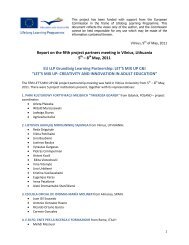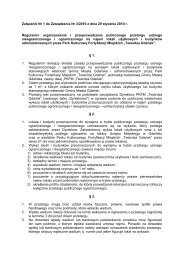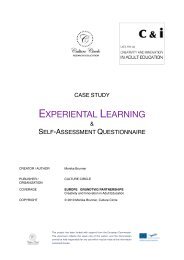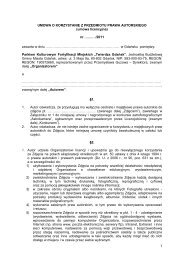AT-Case Study The Performance Factor
AT-Case Study The Performance Factor
AT-Case Study The Performance Factor
You also want an ePaper? Increase the reach of your titles
YUMPU automatically turns print PDFs into web optimized ePapers that Google loves.
!<br />
CRE<strong>AT</strong>IVE LEARNING METHODS<br />
THE PERFORMANCE FACTOR<br />
IN ADULT EDUC<strong>AT</strong>ION<br />
<br />
CRE<strong>AT</strong>OR / AUTHOR<br />
Monika Brunner<br />
PUBLISHER /<br />
ORGANIZ<strong>AT</strong>ION<br />
COVERAGE<br />
COPYRIGHT<br />
CULTURE CIRCLE<br />
EUROPE GRUNDTVIG PARTNERSHIPS<br />
Creativity and Innovation in Adult Education<br />
© 2010 Monika Brunner, Culture Circle<br />
A Project of<br />
This project has been funded with support from the European Commission.<br />
This document reflects the views only of the author, and the Commission<br />
cannot be held responsible for any use which may be made of the information<br />
contained therein.
ABSTRACT<br />
<strong>The</strong> musical theatre challenges to incorporate the three critical areas of theatre performance –<br />
singing, acting and dancing.<br />
Musical theatre actors must be well-versed in a variety of dance styles, be able to effectively<br />
interpret scripts and songs, as well as present themselves professionally in auditions.<br />
KEY POINTS OF SUCCESS:<br />
Adult learners/ students are immersed in the howʼs and whyʼs of acting and teachers will introduce<br />
the following topics:<br />
• Relaxation: How to release tensions that get in the way of acting.<br />
• Method: How to act truthfully moment to moment.<br />
• Scene <strong>Study</strong>: How to identify the dramatic beats of the scene and needs of the characters.<br />
• Movement: How character and action can expressed without words.<br />
• Voice: Use of voice to reveal character.<br />
• Acting for Camera: How to work in front of the lens, hit marks, use eye-lines, create fresh<br />
performances for every take.<br />
2
THE PERFORMANCE FACTOR<br />
Today, musical theatre is alive and booming. New productions and revivals of popular musicals<br />
abound. Competition for musical theatre actors is<br />
intense, and anyone considering a career in this field<br />
needs excellent training to succeed.<br />
<strong>The</strong> musical theatre challenges to incorporate the<br />
three critical areas of musical theatre performance –<br />
singing, acting and dancing.<br />
Adult learners/students will go through rigorous<br />
training in these areas, both in groups and individual<br />
mentorship, and will perform in all disciplines for<br />
invited audiences. Programmes are designed for<br />
individuals with singing and movement abilities who<br />
may or may not have prior experience on a musical<br />
theatre stage.<br />
Musical theatre actors must be well-versed in a<br />
variety of dance styles, be able to effectively interpret<br />
scripts and songs, as well as present themselves<br />
professionally in auditions. Broadwayʼs first long-run<br />
musical appeared in 1857.<br />
<strong>The</strong> following methods allow learners to explore the<br />
integral skills required for success in this field, and to<br />
prepare themselves for the rigorous physical and<br />
emotional demands of a musical theatre career.<br />
SINGING TECHNIQUE:<br />
Adult learners/students will work on the fundamentals of healthy singing: breath support,<br />
diaphragmatic control, natural articulation, relaxation of the neck, face and jaw, and proper use of<br />
body. Other topics may include chest voice, falsetto, head voice, and tone, as well.<br />
3
THE PERFORMANCE FACTOR<br />
SINGING INTERPRET<strong>AT</strong>ION:<br />
Adult learners/ students will apply the concepts being<br />
studied in Scene <strong>Study</strong> and Monologue to Songs, and<br />
will learn to approach a song as a monologue or scene,<br />
while simultaneously employing proper technique.<br />
Monologues are often used for auditions. However,<br />
many stage plays incorporate monologues into their<br />
dramatic structures, which, is why it is essential that<br />
actors learn how to approach the preparation,<br />
execution, and analysis of monologues.<br />
MUSIC THEORY:<br />
An introduction to music fundamentals including note<br />
values, identification of cadences and basic phrase<br />
structures, scales, intervals, harmony, key, chords and<br />
reading proficiency.<br />
PERFORMANCE LAB:<br />
<strong>The</strong> lab is designed to workshop musical scenes for<br />
performance. Scenes will be prepared in complexity<br />
and will require that adult learners/students take on<br />
both independent or lead performances and chorus<br />
roles.<br />
COLD READINGS & AUDITION TECHNIQUE:<br />
Auditioning is a special skill requiring specific techniques. Actors will learn and practice the<br />
essentials of a good audition and focus on the set of skills required to handle cold readings. <strong>The</strong><br />
goal is to help actors make quick, specific, action-oriented choices and to develop strong listening<br />
skills and flexibility in taking direction.<br />
4
THE PERFORMANCE FACTOR<br />
It prepares actors for handling the often nerve-wracking experience of the audition. In addition to<br />
training, successful actors must develop strong marketing skills<br />
in order to build a career. <strong>The</strong> focus is on such topics as<br />
feeling comfortable at cold readings, preparing a resume,<br />
choosing a head-shot photographer, and developing a career<br />
strategy.<br />
VOICE AND SPEECH:<br />
A primary tool for the actor is the expressive and free voice.<br />
<strong>The</strong>refore, voices must be trained to be heard (through volume<br />
adjustments), understood (through articulation) and also felt<br />
(through expression). Adult learners/students gain insight into<br />
the power of how to nurture and control their voices by<br />
exercising various resonators and muscles, enabling them to<br />
release emotional impulses.<br />
In addition to breath work, the focus is on relaxation, phrasing,<br />
and posture as a way of nurturing the actorʼs instrument. Using<br />
text, they learn to identify key words and learn how to link intention with their voice and speak<br />
clearly and powerfully through the end of a line.<br />
Additionally, they will learn the International Phonetic Alphabet (IPA) and apply that learning to the<br />
acquisition of convincing regional dialects and international accents. <strong>The</strong> adult learners/students<br />
will study audio speech samples, transcribe text using IPA, and present monologues and/or scene<br />
work to demonstrate mastery of an accent or dialect.<br />
VOICE AND MOVEMENT:<br />
Learners are taught a repertoire of exercises that increase mental and physical awareness,<br />
improve body alignment, and stimulate natural, reflexive breathing. Adult learners/ students study<br />
how to open channels in the body that controls the vibrations, resonance, and range of the human<br />
voice. <strong>The</strong> workshop directs the actorʼs attention towards the body as an instrument of expression.<br />
Adult learners/students train in uncovering and developing natural movement, and learn how to<br />
overcome inhibitions.<br />
5
THE PERFORMANCE FACTOR<br />
ACTING TECHNIQUE:<br />
From Stanislavskyʼs System to Strasbergʼs Method<br />
and Meisnerʼs Approach, adult learners/students will<br />
fully explore the most effective ways an actor can<br />
“live” truthfully moment to moment and believably<br />
inhabit a role.<br />
Sense memory, emotional recall, and repetition will<br />
all be practiced extensively. Each individual will find<br />
the techniques that allow access to real emotions<br />
that can be used in performance.<br />
Adult learners/students will explore the work of<br />
Konstantin Stanislavski, then move to the Method,<br />
briefly discussing the role of Sanford Meisner (live<br />
truthfully under imaginary circumstances), then continue<br />
to the work of Lee Strasberg (sense and<br />
emotional memory), Jerzy Grotowski (physical<br />
approach/ “outside in”) and Tadashi Suzuki (the way of acting).<br />
Adult learners/students will move to “Open Scenes” and monologue work to begin to utilize the<br />
different concepts studied and will employ elements of these techniques in their performance work.<br />
SCENE STUDY:<br />
Working on scenes from published musicals and dramatic plays allows actors to learn all of the<br />
basic concepts of approaching a scene: defining objectives, breaking the scene down into beats,<br />
understanding the arc, pursuing your objective, playing actions, and working to overcome<br />
obstacles.<br />
It provides techniques for understanding an actorʼs job in relation to a prepared script. It begins at<br />
a foundation level, usually with silent scenes or short dialogue scenes and progresses to longer<br />
dramatic and/or comedic scenes. Scenes are extensively rehearsed and performed. Adult learners/<br />
students receive critiques and adjustments from the instructor and fellows.<br />
6
THE PERFORMANCE FACTOR<br />
TEXT ANALYSIS:<br />
This will explore the history and development of seminal dramatic texts from the 20th century to<br />
the present. Both musical and non- musical plays will be analyzed.<br />
CHOREOGRAPHED DANCE:<br />
Dance techniques employed in musical theatre performance with an emphasis on ballet, jazz, and<br />
tap, and then progresses to individual training sessions in each of these areas. Learners will be<br />
applying the various techniques to choreography specifically for musical theatre.<br />
ACTING FOR FILM AND TELEVISION:<br />
Todayʼs successful actors need to be versatile, and<br />
many stage actors, at times, need to transition<br />
smoothly into film or television roles, and back again.<br />
<strong>The</strong> basic tenets of acting translate from stage to<br />
screen, but there are skills and knowledge that are<br />
specific to the craft of acting for the camera.<br />
Learners will study to calibrate performances based<br />
on shot size and angle, hitting marks, emotional and<br />
physical continuity, as well repetition of verform^ances. <strong>The</strong>y will also explore the movie musical,<br />
and compare and contrast the actorʼs job in stage musicals versus the movie counterparts.<br />
KEY POINTS OF SUCCESS:<br />
Adult learners/ students are immersed in the howʼs and whyʼs of acting and teachers will introduce<br />
the following topics:<br />
• Relaxation: How to release tensions that get in the way of acting.<br />
• Method: How to act truthfully moment to moment.<br />
• Scene <strong>Study</strong>: How to identify the dramatic beats of the scene and needs of the characters.<br />
• Movement: How character and action can expressed without words.<br />
• Voice: Use of voice to reveal character.<br />
• Acting for Camera: How to work in front of the lens, hit marks, use eye-lines, create fresh<br />
performances for every take.<br />
7








